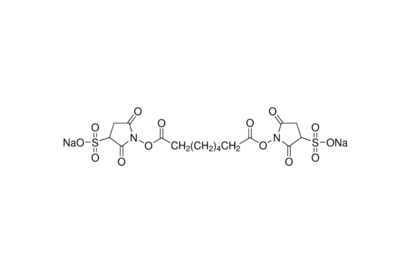產品櫥窗
-
Bis-Sulfosuccinimidyl-suberate sodium salt, BS3
|
產品型號:101-82436-77-9 商品規格: |
 |
Synonym: BS3 Crosslinker. Suberic acid bis(3-sulfo-N-hydroxysuccinimide ester) sodium salt
Chemical Formula: C16H18N2Na2O14S2
Molecular Weight: 572.43
Spacer length: 11.4 Å
Purity: >90%
BS3 crosslinker (Bis[sulfosuccinimidyl] suberate; Sulfo-DSS; BSSS) is an amine-reactive, water soluble, homobifunctional protein crosslinker. Due to BS3 crosslinking reagent's water solubility, conjugation reactions conveniently can take place at physiological conditions. The 8-atom spacer arm of the BS3 crosslinking reagent is non-cleavable and the molecule is not cell membrane permeable. The BS3 protein crosslinker possesses amino reactive Sulfo-NHS esters on both ends of the molecule and can be used to prepare antibody-protein conjugates, for crosslinking cell surface proteins, and for covalently orienting antibody to an immobilized Protein A or Protein G resin.
General BS3 Crosslinking Protocol
1. Allow vial of BS3 Crosslinker to fully equilibrate to ambient temperature before opening to prevent condensation inside the vial (BS3 is moisture-sensitive).
2. Immediately before use, prepare a 50mM solution of BS3, by dissolving 10 mg BS3 in 350 µL of 25 mM Sodium Phosphate, pH 7.4 (do not use amine containing buffers for the conjugation reaction).
3. Using a 20-fold excess approach (20:1 Crosslinker:Protein), add BS3 crosslinker solution to the protein sample so that the final crosslinker concentration is between 0.5 to 5 mM.
4. Allow the sample to react at room temperature for 45 minutes to 1 hour. Allow slightly longer if reaction must be done on ice (this reaction rate is only slightly slower at low temperatures).
5. Quench and unreacted BS3 with 25 mM to 60 mM Tris and allow to react for 10-15 minutes at room temperature.
6. Desalt sample to remove unreacted BS3 crosslinker (i.e. gel filtration, dialysis, etc.).
Molecular Weight: 572.43
Spacer length: 11.4 Å
Purity: >90%
BS3 crosslinker (Bis[sulfosuccinimidyl] suberate; Sulfo-DSS; BSSS) is an amine-reactive, water soluble, homobifunctional protein crosslinker. Due to BS3 crosslinking reagent's water solubility, conjugation reactions conveniently can take place at physiological conditions. The 8-atom spacer arm of the BS3 crosslinking reagent is non-cleavable and the molecule is not cell membrane permeable. The BS3 protein crosslinker possesses amino reactive Sulfo-NHS esters on both ends of the molecule and can be used to prepare antibody-protein conjugates, for crosslinking cell surface proteins, and for covalently orienting antibody to an immobilized Protein A or Protein G resin.
General BS3 Crosslinking Protocol
1. Allow vial of BS3 Crosslinker to fully equilibrate to ambient temperature before opening to prevent condensation inside the vial (BS3 is moisture-sensitive).
2. Immediately before use, prepare a 50mM solution of BS3, by dissolving 10 mg BS3 in 350 µL of 25 mM Sodium Phosphate, pH 7.4 (do not use amine containing buffers for the conjugation reaction).
3. Using a 20-fold excess approach (20:1 Crosslinker:Protein), add BS3 crosslinker solution to the protein sample so that the final crosslinker concentration is between 0.5 to 5 mM.
4. Allow the sample to react at room temperature for 45 minutes to 1 hour. Allow slightly longer if reaction must be done on ice (this reaction rate is only slightly slower at low temperatures).
5. Quench and unreacted BS3 with 25 mM to 60 mM Tris and allow to react for 10-15 minutes at room temperature.
6. Desalt sample to remove unreacted BS3 crosslinker (i.e. gel filtration, dialysis, etc.).
Store at 4oC. For long term storage, -20oC will be better.


